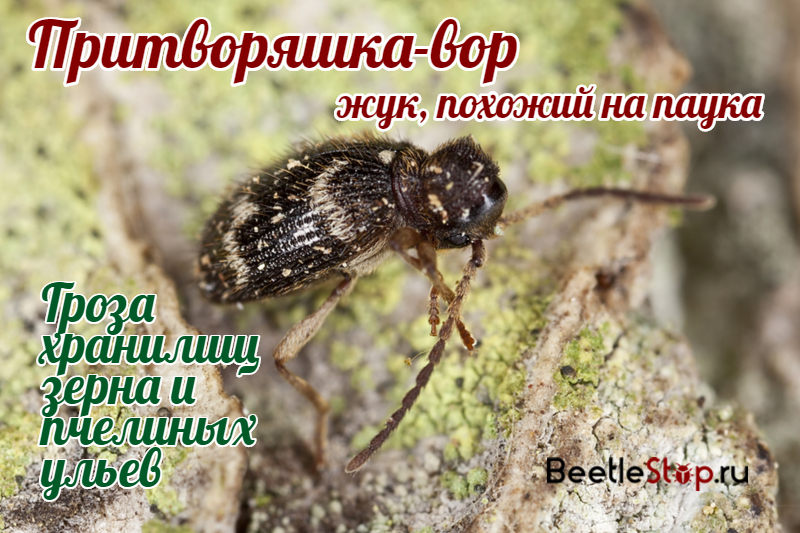Thief-Thief - Night Pest Stocks
Pretenders are a family of beetles that are very close in their lifestyle and appearance to grinders. It has 450 species, of which 27 are considered pests. They often live near a person, damage grain and other food products. The pretenses have a more rounded body, and the antennae and limbs are longer than the grinders. Among the most common types of pests, a pretender is a thief, a pretender is hairy. Adults and insect larvae are multinivorous. Under natural conditions found on plant debris, in burrows of rodents and bird nests.

View description
The pretended thief (Ptinusfur) is a beetle that looks like a spider. This is a member of the Ptinidae family, known for its ability to pretend to be dead. In case of danger, the beetles bend their antennae and limbs under the body and fall from the object on which they crawled. Small adults: male - 4.3 mm, female - 3.1 mm. Sexual dimorphism is manifested in the color and structure of the body of beetles.
The male is oblong, the abdomen is cylindrical in shape. The color is uniform - red or brown. The base of the pronotum is constricted, the surface is covered with brown hairs. The antennae are long, filiform, reaching half the body. The eyes are large, convex, located on the sides of the head. Elytra covered with longitudinal rows of punctures. The hind wings are well developed, males are able to fly a short distance.
The body of the female is spherical in shape, the color is brown-black. The pronotum is divided in the middle by a deep longitudinal furrow, on the edges of which there are tubercles with short stiff hairs. The antennae are shorter than that of the male. Elytra punctured, rounded at the back. There are two light dressings. The wings are reduced. The limbs are brown.
Distribution area
Representatives of the species Ptinusfur are called cosmopolitans; they live in all parts of the world. In cold regions it is found in heated rooms. In Hungary, beetles are classified as quarantine objects.
Lifestyle & Reproduction
Beetles lead a nocturnal lifestyle, during the day they hide in dark places, crevices. Under natural conditions or unheated rooms, one generation develops per year. The synanthropic relationship with humans facilitated the procurement of food and allowed multiplication year-round in comfortable conditions. Beetles are thermophilic, they prefer existence at 20-25 °. The life expectancy of adults is directly dependent on temperature. In warmth, all life processes are accelerated, offspring develop faster, and life expectancy is reduced by 2-3 times.
Information. In favorable conditions, at temperatures above 25 °, a pretense-thief gives 3 generations.
Breeding
Females lay eggs in spring, fertility up to 170 pieces. Oval white eggs are left on larvae food. Embryonic development takes 19-22 days. The larva is fleshy, white with a reddish head. The body is covered with thin yellow hairs. There are three pairs of chest legs. It grows to 5.5 mm. Nutrition - products of plant and animal origin. In the process of growing up, 3 molting takes place. Development takes up to two months. In adverse conditions, the larva falls into diapause.
Before pupation, a cradle is built among food products.A pupa with a size of 3.5-4.5 mm can be on the floor, walls, in a bound book. The imago appears after 3 weeks.
Information. The pretending thief is resistant to external influences. The larvae tolerate cold at -5 °, at -10 ° they can live a month.
Malware
Polyphagous insects settle in granaries, food warehouses, museums, apartment buildings, confectionery and pasta factories.
When feeding and breeding, they damage:
- cereals and grain;
- entomological and botanical collections;
- upholstered furniture;
- book bindings;
- plants' seeds;
- meat, sausages;
- fur, leather, woolen fabrics.
Information. Ptinusfur larvae are a real disaster for herbaria. They clog collections with waste powder.
The pretending thief is a pest of bee hives. Insects, getting to the apiary, feed on warming fabrics and felt, bee bread, dead brood. Beetles damage the honeycomb and the walls of the hive. Their presence gives out the appearance of crumbs, noticeable moves. As a prevention, it is recommended to dry the insulation and maintain cleanliness in the hive.
Methods of struggle
To destroy the pest, the grain is alternately heated, cooled and cleaned. Chemical methods of control are applied. Food products are fumigated in special chambers. They are treated with phosphine gas. For spraying grain using contact insecticides. To prevent infection, clean and disinfect rooms. Dry granules are best placed in granaries.


 (votes: 3, average rating: 4,33 out of 5)
(votes: 3, average rating: 4,33 out of 5)